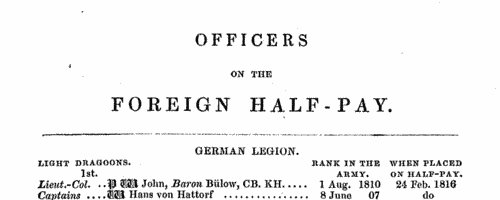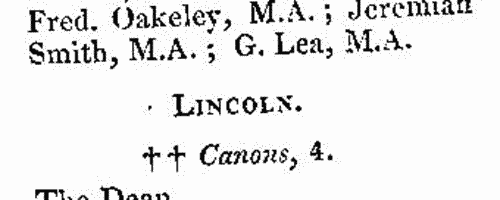Add this eBook to your basket to receive access to all 378 records. Our indexes include entries for the spelling bathurst. In the period you have requested, we have the following 378 records (displaying 231 to 240): These sample scans are from the original record. You will get scans of the full pages or articles where the surname you searched for has been found. Your web browser may prevent the sample windows from opening; in this case please change your browser settings to allow pop-up windows from this site. Retired officers of the British Army
(1840)
The New Annual Army List, corrected to 7 February 1840, was published in London by Lieut. H. G. Hart. The section entitled 'Officers on Foreign Half-Pay' lists all such officers, by rank from captain down to ensign, with paymasters, adjutants, quarter-masters, and veterinary surgeons. These lists are annotated with dates of rank, and when placed on half-pay, and with symbols indicating the officers present in the Peninsula or the South of France (P), and Waterloo (W). The officers were from the German Legion, Brunswick Cavalry, Brunswick Infantry, Chasseurs Britanniques, Corsican Rangers, Dillon's, Greek Light Infantry, Maltese troops, Meuron's, Roll's, Sicilian, Watteville's, York Light Infantry, Veteran Battalion, Waggoners, and Medical Department. | Sample scan, click to enlarge

| British Army officers
(1841)
The Royal Kalendar lists general and field officers of the British Army - five Field Marshals, 95 generals, 138 major-generals, 310 colonels, 637 lieutenant-colonels, 697 majors, in order of precedence according to year of precedence, and with the regiment indicated for each; then there are aides-de-camp to her Majesty queen Victoria; retired officers specially allowed to retain their ranks; and then the queen's land forces, set out regiment by regiment and battalion by battalion, naming the colonel, lieutenant-colonel and major for each, officers of the British garrisons, and of the Tower of London; and the officers of the Royal Regiment of Artillery (including the Field Train) and the Corps of Royal Engineers, by rank. | Sample scan, click to enlarge

| Churchmen and church officers in England and Wales
(1841)
The Royal Kalendar has an extensive ecclesiastical section, giving the names of officials at the College of Doctors of (church) Law, the Ecclesiastical Courts, and the ecclesiastical law proctors; deans, chancellors, archdeacons, canons and prebendaries for all the dioceses of England and Wales; the officers and fellows (being all the parish priests within and without the walls of London) of Sion College; and the incumbents of the parishes within ten miles of London (annotated to show whether rectors, vicars or curates, and with the net annual revenue of each cure); the Ecclesiastical Commissioners for England; the Committee of Council on Education; and then the officers of the various religious societies (Queen Anne's Bounty Office, and First-Fruits and Tenths Offices; Commissioners for Building Additional Churches; Society for Promoting the Building of Churches and Chapels; Anniversary Festival of the Sons of the Clergy; Society for Promoting Christian Knowledge; Society for the Propagation of the Gospel in Foreign Parts; Dissenters' Library; Society for Maintaining and Educating Poor Orphans of Clergymen of the Established Church; Society for Promoting Religious Knowledge; Patrons of the Anniversary of the Charity Schools; Naval and Military Bible Society; Society for the Support and Encouragement of Sunday Schools throughout the British Dominions; Society for Extending the Christian Faith in the British West India Islands; London Missionary Society; Religious Tract Society; Society for the Suppression of Vice; British and Foreign Bible Society; Church Missionary Society; Prayer Book and Homily Society; Dr Bray's Institution; London Society for Promoting Christianity among the Jews; National Society for the Education of the Poor in the Principles of the Established Church; Church Pastoral Aid Society; European Missionary Society; British Society for Promoting the Religious Principles of the Reformation; and the Protestant Association). | Sample scan, click to enlarge

| English civil servants
(1841)
The Royal Kalendar lists officers and officials of a number of government bodies in London: Privy Seal, the Secretary of State's Office (including the Home, Irish, Foreign and Colonial departments, and the Colonial Land and Emigration Board) , the Queen's Mint, the Board of Council for Trade and Foreign Plantations; the Board of Commissioners for the Affairs of India; the Office of her Majesty's Woods, Forests, Land Revenues, Works and Buildings (including some officials in Scotland and the provinces, and the rangers and keepers of the royal parks); the State Paper Office; the Signet Office; Alien Department; Registry of Colonial Slaves; Establishment of Queen's Messengers; the Treasury Office; Commissariat Department; Receipt of Exchequer; Office of Paymasters of Exchequer Bills; Stationery Office; General Register Office; Poor Law Commission; Commissioners of Slave Compensation; Reduction of the National Debt and Life Annuity Office; and the Exchequer Bill Loan Office for Public Works and Fisheries. | Sample scan, click to enlarge

| Households of the minor royalty
(1841)
The Royal Kalendar lists the principal officials of the households of their Royal Highnesses the Princess Sophia, the Duchess of Kent, the Duchess of Gloucester, and the Princess Sophia Matilda. Princess Sophia was born in 1777, fifth daughter of king George III. Victoria Mary Louisa was the widow of Edward duke of Kent and Strathern (fourth son of George III) who died in 1820. Mary, fourth daughter of George III, married her cousin William Frederick duke of Gloucester. Princess Sophia Matilda, born in 1773, was his sister. | Sample scan, click to enlarge

| Officers and officials of English hospitals
(1841)
The Royal Kalendar lists patrons, governors, officers and staff of the hospitals and infirmaries in and near London: Saint Bartholomew's; the Bridewell and Bethlem; St Thomas's; Emanuel; Asylum for Poor French Protestants; Westminster Hospital; Guy's; Bancroft's Hospital; St George's; the Foundling Hospital; the London Hospital; the Hospital for Casual Smallpox and Vaccination; Lock Hospital; Middlesex Hospital; the British Lying-in Hospital for Married Women; the City of London Lying-in Hospital; St Luke's Hospital for Lunatics; Queen Charlotte's Lying-in Hospital; the Asylum for French Orphans; the General Lying-in Hospital; the Jews Hospital; Seamen's Hospital Society; Magdalen Hospital; London Fever Hospital; Royal London Ophthalmic Hospital; Royal Sea Bathing Infirmary (at Westbrook near Margate); Royal Infirmary for Diseases of the Eye; Royal Westminster Ophthalmic Hospital; Infirmary for Asthma, Consumption and other Diseases of the Lungs; Charing Cross Hospital and Medical College; the Royal Metropolitan Hospital for Children; the Royal Maternity Charity for delivering Poor Married Women at their own Habitations; the General Dispensary for Relief of the Poor; Westminster General Dispensary; London Dispensary; Finsbury Dispensary; the Eastern Dispensary; the Public Dispensary; Marylebone General Dispensary; Queen Adelaide and British Ladies Lying-in Institution; the City Dispensary; the Western Dispensary; Surrey Dispensary; Tower Hamlets Dispensary; Bloomsbury Dispensary; the National Truss Society; the Rupture Society for the Supply of Trusses to the Indigent Poor; the City of London Truss Society; the National Vaccine Establishment; the Charitable Fund and Dispensary for Relieving the Sick Poor at their own Habitations with Medicines and Pecuniary Aid; the Northern Dispensary; the Royal Infirmary for Children; the Royal Dispensary for the Diseases of the Ear, and the Deaf and Dumb; the Royal Jennerian and London Vaccine Institution for the Extermination of Smallpox, for Gratuitous Vaccination, and Keeping up a Genuine Ichor; and St George's and St James's Dispensary. | Sample scan, click to enlarge

| Officials and officers of the Admiralty, dockyards, and maritime institutions
(1841)
The Royal Kalendar lists officials and clerks of the Admiralty at Charing Cross, including those of the Admiralty Court; then there are the various civil departments of the Admiralty at Somerset Place: the Surveyor's Department, the Accountant-General's Department, Storekeeper-General's Department, Department of the Comptroller for Victualling and Transport Services; Department of the Physician-General; the Dockyards at Deptford, Woolwich, Chatham, Sheerness, Deal, Portsmouth, Plymouth, Pembroke, Halifax (Nova Scotia), Malta, Cape of Good Hope, Trincomalee and Bermuda; the Victualling Officers at the outports of Deptford, Portsmouth, Plymouth, Sheerness and Cork; the Royal Naval Hospitals at Haslar, Plymouth, Malta, Jamaica and Bermuda; the Royal Marines' Navy and Marine Agents in London; the Royal Hospital at Greenwich; Royal Hospital School; Corporation of the Trinity House; Corporation for Sick and Maimed Seamen in the Merchants Service; Royal Naval Benevolent Society; Naval Medical Supplemental Fund; Marine Society; London Maritime Institution; Royal National Institution for the Preservation of Life from Shipwreck; and the Royal Naval School for Educating the Sons of the Less Affluent Naval and Marine Officers at the Least Possible Expense. | Sample scan, click to enlarge

| Petitioning Creditors and Solicitors
(1841)
Principal creditors petitioning to force a bankruptcy (but often close relatives of the bankrupt helping to protect his assets): and solicitors | Sample scan, click to enlarge

|  Persons of standing recommending London police recruits
(1830-1842) Persons of standing recommending London police recruits
(1830-1842)
The Metropolitan Police Register of Joiners (MEPO 333/4) lists policemen joining the force through to 31 December 1842 (to warrant number 19892). The register is alphabetical, in so far as the recruits are listed chronologically grouped under first letter of surname. It is evidently a continuation of a similar earlier register, not closed until its alphabetical sections were filled: consequently, there are no entries in this register for the initial letters N, O, Q, U, V, X, Y or Z; and the sections of this register start at different dates - A 18 April 1840 (warrant number 16894); B 11 December 1830 (5570); C 7 September 1830 (4988); D 27 May 1833 (8445); E 15 December 1838 (14476); F 30 March 1832 (7372); G 1 December 1835 (11,184); H 25 April 1832 (7457); I and J 13 February 1837 (12449); K 2 January 1838 (13457); L 3 October 1834 (9905); M 15 November 1832 (7999); P 4 October 1831 (6869); R 4 September 1837 (13021); S 30 March 1835 (10366); T 6 April 1840 (16829); W 30 December 1833 (9096). The register gives Date of Appointment, Name, Number of Warrant, Cause of Removal from Force (resigned, dismissed, promoted or died), and Date of Removal. Those recruits not formerly in the police, the army, or some government department, were required to provide (normally) at least two letters of recommendation from persons of standing, and details of these are entered on the facing pages: the names in these are indexed here (the police recruits are indexed separately and not included here). Recruits transferred from other forces or rejoining the force did not normally need recommendations - in the latter case, former warrant numbers are given - but some recommendations are from police inspectors, even other constables. Recruits coming from the army sometimes have general military certificates of good conduct, but most often have a letter from their former commanding officer; recruits recommended by government departments (most often the Home Office) similarly have letters from the head of department. But the great majority of the names and addresses in these pages are of respectable citizens having some sort of personal acquaintance with the recruit. Where more than two recommendations were provided, the clerk would only record one or two, with the words 'and others'. Tradesmen are sometimes identified as such by their occupations; there are some gentry. Although the great bulk of these names are from London and the home counties, a scattering are from further afield throughout Britain and Ireland. | Sample scan, click to enlarge

| Bankrupts' Assignees
(1842)
Assignees of bankrupts' estates (usually principal creditors and/or close relatives of the bankrupt) in England and Wales | Sample scan, click to enlarge

|
Research your ancestry, family history, genealogy and one-name study by direct access to original records and archives indexed by surname.
|












